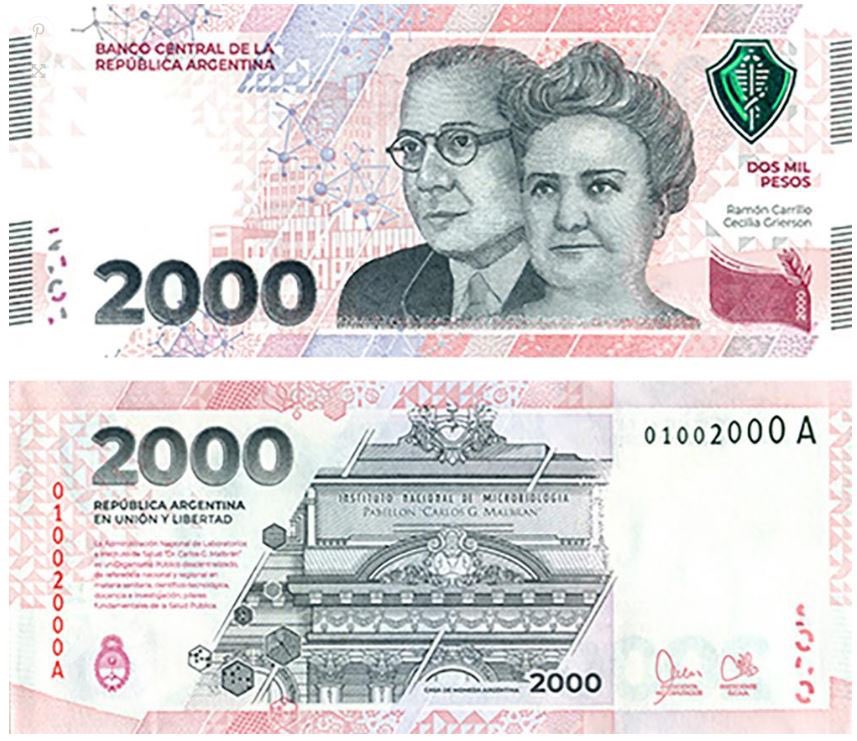Inspenet, May 23, 2023
The Central Bank of the Argentine Republic (BCRA) put into circulation a new commemorative note of 2,000 pesos of legal tender, which will be progressively distributed through the network of bank branches throughout the country.
The new legal commemorative banknote, which integrates the current Peso Line, is distinguished from other denominations by presenting shades of dark gray and pink as predominant colors.
On the obverse are the portraits of Dr. Cecilia Grierson and Dr. Ramón Carrillo, precursors in the development of medicine in Argentina, while the reverse represents the building of the National Institute of Microbiology Dr. Carlos G. Malbrán, in homage to science and Public Health in Argentina.
The 2,000-peso commemorative note has strict security measures. Among them, the watermark that reproduces the images of Ramón Carrillo and Cecilia Grierson and the optical variability ink that changes color, with a three-dimensional dynamic effect, stand out. In addition, it presents microprints, latent image, front-back complementation motif, and magnetic, infrared, and luminescent inks.
Regarding the facilities for blind people, it incorporates a new identification code with relief perceptible to touch.

The new banknote was designed in collaboration with the Argentine Mint
The way in which people make payments in our country has been undergoing an important change towards a greater use of electronic means, a process that has been strongly promoted by the BCRA through innovative and high-impact measures and programs, as Transfers 3.0. While the payment digitization process progresses, this higher denomination bill will improve the operation of ATMs and at the same time optimize the transfer of cash.

A tribute to the heroes of medicine, protagonists of the 2,000-peso bill
This new banknote was designed as a tribute to Public Health, the development of science and medicine in Argentina.
Cecilia Grierson was born in Buenos Aires on November 22, 1859 and died in the same city on April 10, 1934. She was the first doctor in Argentina, graduated in 1889 from the Faculty of Medicine of the University of Buenos Aires. Grierson practiced as an obstetrician and kinesiologist, but she was never able to work as a surgeon because she was a woman, despite having the qualifying title of the specialty. From a young age he also dedicated himself to teaching, a task that he never abandoned. At the same time, she tirelessly fought for women’s rights.
Grierson created the First School of Nursing in Latin America with a formal curriculum, and was also a founding member of the Argentine Medical Association. She was also a pioneer in the idea of opening first aid rooms in different towns to help with primary care for the sick. He played a key role during the cholera epidemic that affected the City of Buenos Aires in 1886.
Born on March 7, 1906 in Santiago del Estero, Ramón Carrillo was a neurosurgeon, neurologist, sanitary doctor and the first Minister of Health of the Nation. He graduated with a Medal of Honor from the Faculty of Medicine of the University of Buenos Aires. He was full professor of the Department of Neurosurgery and abandoned his brilliant career as a neurologist to dedicate himself to the development of social medicine.
Carrillo made a great transformation in the public health of our country from a social conception of medicine. During his tenure as Minister of Public Health, which lasted eight years between 1946 and 1954, a significant number of public hospitals were created and massive vaccination campaigns were carried out, making the use of vaccination certificates compulsory for schools. It eradicated endemic diseases such as malaria in 2 years. It ended epidemics like typhus and brucellosis, and drastically reduced the infant mortality rate. He promoted the incorporation of the health train that traveled throughout the country for 4 months of the year doing clinical analysis, x-rays, medical and dental care.
Ramón Carrillo died on December 20, 1956 in the city of Belén, in Brazil.
The National Administration of Laboratories and the Dr. Carlos Malbrán Health Institute is a decentralized public body whose fundamental mission is to participate in scientific and technical policies related to health aspects. It was founded in 1893 with the aim of producing biological products to treat infectious diseases. The institution adopted the name of the famous doctor in 1941.
Important scientists such as Nobel laureates Bernardo Houssay and César Milstein worked at the Malbrán.
Source and images : https://www.bcra.gob.ar/Noticias/El-BCRA-pone-en-circulacion-el-billete.asp
Don’t miss the Inspenet News at: https://inspenet.com/inspenet-tv/


